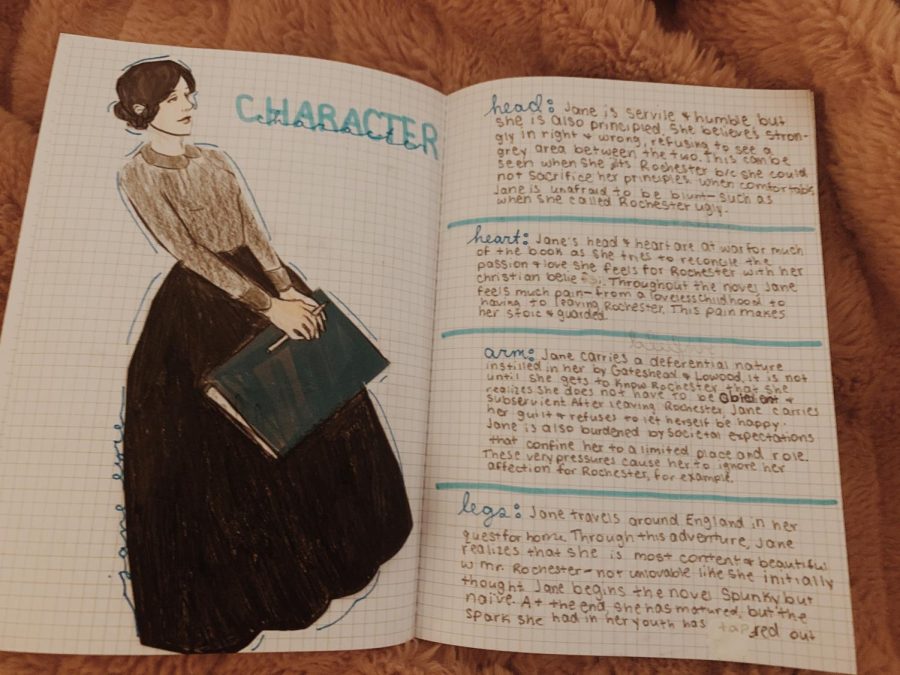The AP Lit project helps students deepen their understanding while expressing their creativity

More stories from Eva Harshman
A project from a past year that shows the creative potential in the assignment
When students walk into English teacher Lisa Penninga’s classroom, they don’t usually imagine reading a cold, gothic, and creepy book in such a warm and inviting classroom. However, this is precisely what the AP Literature class is doing for their biggest project yet.
The project is fairly open-ended; however, it must be based upon a student’s chosen book club book. Frankenstein by Mary Shelley, Jane Eyre by Charlotte Bronte, and The Picture of Dorian Gray by Oscar Wilde are the dark, gothic novels that the students can choose as their book club focus.
“I really liked that all three books had a Byronic hero,” Penninga said, “which is coined after Lord Byron. So, they kind of have that commonality—all three have gothic tones. It’s a fun fall read because all three have a mysterious, creepy setting in some part of their book, so it’s an easy one to combine all three books together with full-class discussions, but also have their individual book club discussions too.”
Though the assignment is 200 points, Penninga isn’t just assigning this project for the students to get another grade in their PowerSchool. This major project is the perfect way to tie in the crucial pillars of the AP Lit class.
Character, setting, narration, structure, and figurative language are what Penninga calls the “Fab Five.” These five principles are what the latest project brings together.
“Usually, this is the project where all of the Fab Five come together,” Penninga said. “[The students] realize that the setting does impact the character; the structure impacts the reader and the overall meaning. The point of view is really important. It brings all five of the components together.”
Senior Thomas Cobb has been able to deeply explore the gothic genre through this project. He selected The Picture of Dorian Gray as his book club novel and has followed the twists and turns throughout the chapters.
Additionally, due to the complexity of the plots and language in these books, they give the reader an extra challenge to tackle when reading. However, this also leaves the door open for interpretation, which is an interesting element to Thomas.
“I think that a lot of it is really [up to] interpretation with how different people like to read different things,” Thomas said. “I really like the genre—it’s gothic-horror—and there’s a lot of surprising elements.”
While not all students have begun their project yet, Thomas has made progress on what he plans to present.
Thomas plans to take a more digital approach to this assignment rather than an artistic one. He is creating a Google Slides presentation and a word cloud to demonstrate his understanding of The Picture of Dorian Gray.
“With my word cloud, I assembled a certain shape to symbolize some of the themes in the book,” Thomas said. “I made the word cloud in the shape of an English pound to symbolize the money, wealth, and greed in London.”
Senior Julianna Hahn, who is also reading The Picture of Dorian Gray, is enthusiastic to see what this project will hold. Despite the difficulties the novel holds, Juliana has enjoyed her experiences with the book she has chosen.
Furthermore, she sees the benefits that such a meaningful project can bring. Though it is hard work, it will certainly pay off when she goes to take the exam; specifically, this project will help her learn more about the Fab Five.
“I think that this project will help me to better analyze the characters and [their] purpose in the story,” Julianna said. “This will help me see how the narrator plays a role in telling the story. In this book specifically, the narrative is very scattered and chaotic [which] adds to the confusion and mystery of the book.”
Not only does the way this unit is taught give the students a chance to be creative and a chance to grow in their analytical skills, but the format of the project does this as well.
Since the project is so open-ended, the students are free to express themselves within their work and enjoy what they do by selecting the type of presentation that fits their interests the most.
“I like the concept of this project; the open-ended way to complete it is nice, [and] there is a lot of room for creativity,” Julianna said. “I particularly like the idea of the character map so I can really delve deep into a certain character, [and] the six-word memoir section for each significant character [lets me] reflect on the relationship between each character and their purpose in the story.”
While learning about the book is essential to the project, it also allows students to take a step back and look at the big picture. Zooming out to the genre as a whole brings students back to the foundation of AP Lit.
The Fab Five are all deeply intertwined in the novels that the students are reading, making them the perfect options for an AP Lit class.
“It usually is that aha moment for students to realize what we’re trying to do with the book that we read,” Penninga said. “It helps students understand the foundation of the class.”

Eva Harshman is a senior who is thrilled to be entering her fourth and final year on staff as Editor-in-Chief. Apart from writing for The Central Trend, she...


























































































Samantha Unterfrananz • May 4, 2022 at 11:16 am
What is the project and parameters of the assignment? I would like to do something like this in my classroom. Thanks!